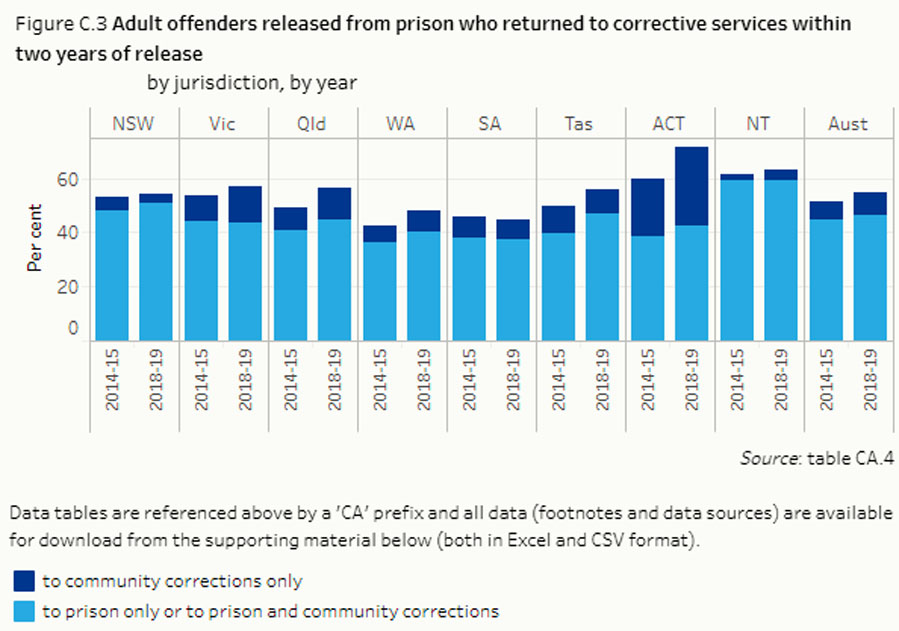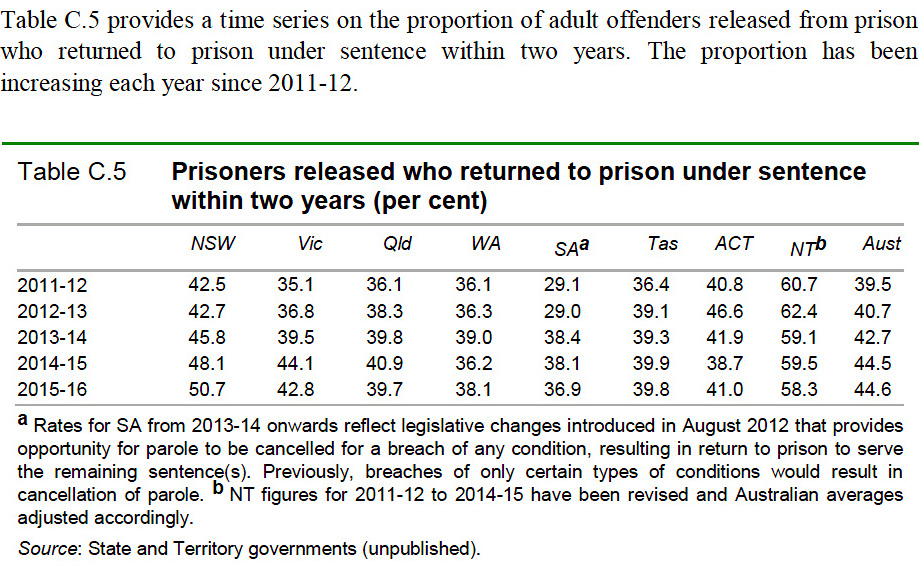Defined Terms and Documents 'Aboriginal Teenager Life Skills' RTV Social Inclusion Early Intervention Programme
High Recidivism/re-offending rates in Australia or Australia's Whacko Recidivism Rates
Recidivism among prisoners in Australian gaols is measured by the rate at which released prisoners return to prison. 54.2% of released prisoners in Australia returned to corrective services in the two years to 2017–18. This includes people who returned to prison, as well as people who were subsequently placed on community orders.
Below is an extract from Report on Government Services 2020 which evidences that across the six States and two Territories, 50% circa of inmates released from prison in 2016-17 had returned to prison incarceration within two years, namely by 2018-19. By providing data fro 2014-15, the below Figure 3 enables a comparison as to whether recidivism is higher stable or lower across these eight government domains:
Adult offenders released from prison
In 2018‑19, 46.4 per cent of prisoners released in 2016-17 had returned to prison with a new sentence within two years (some of those returning to prison may also have received community corrections orders). In total, 54.9 per cent of released prisoners returned to corrective services (either prison or community corrections). Nationally, these rates have increased over the last five years (figure C.3).
Below is an extract from Gendreau, P., Goggin, C., & Cullen, F. (1999). The effects of prison sentences on recidivism. Ottawa, ON: Solicitor General Canada:
"The essential conclusions reached from this study were:
1. Prisons should not be used with the expectation of reducing criminal behaviour.
2. On the basis of the present results, excessive use of incarceration has enormous cost implications.
3. In order to determine who is being adversely affected by prison, it is incumbent upon prison officials to implement repeated, comprehensive assessments of offenders’ attitudes, values, and behaviours while incarcerated.
4. The primary justification of prison should be to incapacitate offenders (particularly, those of a chronic, higher risk nature) for reasonable periods and to exact retribution."
Below are two extracts from the Sentencing Advisory Council's paper titled Does Imprisonment Deter? A Review of the Evidence dated April 2011:
deterrent effect. However, the research also indicates that increases in the severity of penalties, such as increasing the length of terms of imprisonment, do not produce a corresponding increase in deterrence."The evidence from empirical studies of deterrence suggests that the threat of imprisonment generates a small
general
Research into
specific deterrence shows that imprisonment has, at best, no effect on the rate of reoffending and often results in a greater rate of recidivism.""The research shows that imprisonment has, at best, no effect on the rate of reoffending and is often criminogenic, resulting in a greater rate of recidivism by imprisoned offenders compared with offenders who received a different sentencing outcome."
Over 50% of inmates released from The University Of Crime at Australia's state and territory prisons, return to prison within 2½ years, largely due to the loss of life sustaining skills that inmates are often confronted by upon release from a highly institutionalised environment, namely “institutionalised personality traits”, including “distrusting others, difficulty engaging in relationships [and] hampered decision-making”.
Call for a complete rethink as prison population, recidivism explode - SMH - Rachel Olding - Feb 2016 includes:
receiving prison terms for minor crimes; and
Australia's Criminal Justice Costs: An International Comparison - April 2017 prepared by Andrew Bushnell, Institute of Public Affairs reported:
A. Australia spends an estimated $16 billion a year on our criminal justice system (police services, courts and correctional services/prisons).
B. 36,000 inmates in Australia's prisons, up 39 per cent from a decade ago - the prison system costs the Australian taxpayer $4 billion annually.
C. Australia's $4 billion annual prison system has created a "class of persistent criminals":
(i) 58 percent of prisoners have been imprisoned before (stable over the past 10 years)
(ii) 44.6 percent of prisoners released during 2013-14 returned to prison within two years (up from 39.5 percent five years ago)
(iii) 52.6 percent of prisoners released during 2013-14 returned to corrective services within two year
Below is an extract of Table C.5 of Report on Government Services 2017 - Volume C: Justice which evidences that -
* 50.7% of inmates in NSW; and
* 58.3% of inmates in N.T,
released in 2013-14 had returned to prison within two years.
Below is an extract of Table CA.4 of Report on Government Services 2018 - CA Justice Sector Overview - attachment which evidences that -
* 51.3% of inmates in NSW; and
* 57.1% of inmates in N.T,
released in 2014-15 had returned to prison within two years.
See:
Vocational education and training provision and recidivism in Queensland correctional institutions
With rising rates of imprisonment, CEDA Chief Economist, Jarrod Ball, explores the cost of recidivism to the Australian economy - CEDA - Jarrod Ball | 2 July 2019
"The human costs of increasing imprisonment are devastating but often hidden from public sight. But the economic costs are increasingly obvious, eating up taxpayer dollars, hitting state budgets and impacting the productive potential of our economy.
According to the Productivity Commission, the annual cost of prisons in Australia reached over $4.6 billion in 2017-18, equating to $302 per prisoner per day."
After prison network - CEDA Chief Economist, Jarrod Ball, explores the cost of recidivism to the Australian economy - CEDA -
Queensland Productivity Commission summary report into imprisonment and recidivism - AUGUST 2019

